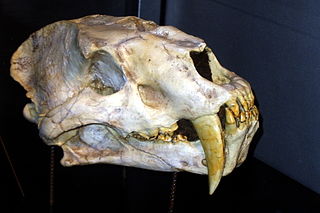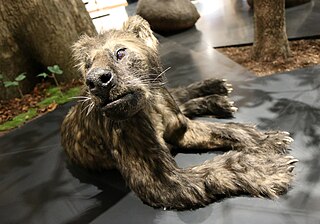
Proailurus is an extinct felid genus that lived in Europe and Asia approximately 25-30.8 million years ago in the Late Oligocene and Miocene. Fossils have been found in Mongolia, Germany, and Spain.

Pseudaelurus is a prehistoric cat that lived in Europe, Asia and North America in the Miocene between approximately twenty and eight million years ago. It is considered to be a paraphyletic grade ancestral to living felines and pantherines as well as the extinct machairodonts (saber-tooths), and is a successor to Proailurus. It originated from Eurasia and was the first cat to reach North America, when it entered the continent at about 18.5 Ma ending a 'cat-gap' of 7 million years. The slender proportions of the animal, together with its short, viverrid-like legs, suggest that it may have been an agile climber of trees.

The Knife Tooth Cat (Machairodus) is a genus of large machairodont or ''saber-toothed cat'' that lived in Africa, Eurasia and North America during the late Miocene. It is the animal from which the subfamily Machairodontinae gets its name and has since become a wastebasket taxon over the years as many genera of sabertooth cat have been and are still occasionally lumped into it.

Nimravidae is an extinct family of carnivorans, sometimes known as false saber-toothed cats, whose fossils are found in North America and Eurasia. Not considered to belong to the true cats, the nimravids are generally considered closely related and classified as a distinct family in the suborder Feliformia. Fossils have been dated from the Middle Eocene through the Late Miocene epochs, spanning about 33.2 million years.
Paramachaerodus is an extinct genus of saber-tooth cat of the subfamily Machairodontinae, which was endemic to Eurasia during the Middle and Late Miocene from 15 to 9 Ma. A 2022 phylogenetic analysis suggested that the genus may be polyphyletic.

Amphicyon is an extinct genus of large carnivorans belonging to the family Amphicyonidae, subfamily Amphicyoninae, from the Miocene epoch. Members of this family received their vernacular name for possessing bear-like and dog-like features. They ranged over North America, Europe, Asia, and Africa.

Barbourofelidae is an extinct family of carnivorans of the suborder Feliformia, sometimes known as false saber-toothed cats, that lived in North America, Eurasia and Africa during the Miocene epoch and existed for about 7.9 million years. Thought to be an independent lineage from the Nimravidae and Machairodontinae, which had all attained elongated canines, recent research argues that it may be a subfamily of the Nimravidae, extending its biochronological range into the Miocene, although this issue is not yet fully resolved.

Simocyon is a genus of extinct carnivoran mammal in the family Ailuridae. Simocyon, which was about the size of a mountain lion, lived in the late Miocene and early Pliocene epochs, and has been found in Europe, Asia, and rarely, North America and Africa.
Ginsburgsmilus is an extinct genus of carnivorous mammal of the family Barbourofelidae that was endemic to Africa during the early Miocene. There is only one known specimen of Ginsburgsmilus napakensis, dated to 20-19 mya.

Pristifelis is an extinct genus of feline from the late Miocene. It contains a single species, Pristifelis attica. The first fossil skull of P. attica was excavated near Pikermi in Attica, Greece. Fossils were also excavated near the Moldovan city of Taraclia. It was also discovered in Maragheh, northwestern Iran. P. attica was bigger in body size than a European wildcat but probably smaller than a serval. The species was first described as Felis attica by Johann Andreas Wagner in 1857. Due to size differences, it was proposed as type species for the genus Pristifelis proposed in 2012.

Cerro de los Batallones is a hill at Torrejón de Velasco, Madrid, Spain where a number of fossil sites from the Upper Miocene (MN10) have been found. Nine sites have been discovered with predominantly vertebrate fossils, invertebrates and plants being less represented. The first deposits were discovered accidentally in July 1991.

Amphimachairodus is an extinct genus of large machairodonts. It is also a member of the tribe Homotherini within Machairodontinae and is most closely related to such species as Xenosmilus, Homotherium itself, and Nimravides. It inhabited Eurasia, Northern Africa and North America during the late Miocene epoch.

Promegantereon is an extinct genus of machairodont from the Miocene of Europe. It is one of the oldest machairodont cat species in the Smilodontini and is believed to be an ancestor of Megantereon and Smilodon.

Magericyon is an extinct genus of Amphicyonid ("bear-dog") that lived during the Miocene 10-9 Ma in what is now Spain.
Styriofelis is an extinct genus of Felidae known from the Miocene of Europe.
Miopanthera is an extinct genus of Pseudaelurus-grade felids.
Ammitocyon is a genus of large sized carnivoran mammals, belonging to the Amphicyonidae, that lived during the Late Miocene in what is now Spain. It is notable for its extreme adaptations towards hypercarnivory, its extremely robust skeleton, and was one of the last surviving members of its family.

Thaumastocyoninae is an extinct subfamily of amphicyonids, large terrestrial carnivores, which inhabited what is now Europe during the Miocene epoch. The subfamily was erected by Hürzeler (1940), and is defined by the complete suppression of m1 metaconid, reduction of the premolars, except the p4, which is reinforced, and the oblique abrasion of the teeth, and the possession of hypercarnivorous tendencies. Thaumastocyonines are poorly known, with only about 65 dental specimens, most of those isolated teeth, being known as of 2020, although more complete remains have recently been discovered.
Protursus is a fossil genus of ailurid with a single species Protursus simpsoni, known from a single left m2 tooth.
Magerifelis is an extinct genus of feline with only one species assigned to it, Magerifelis peignei. It was described in 2024 based on seven fossils from the middle Miocene of Spain and France.













